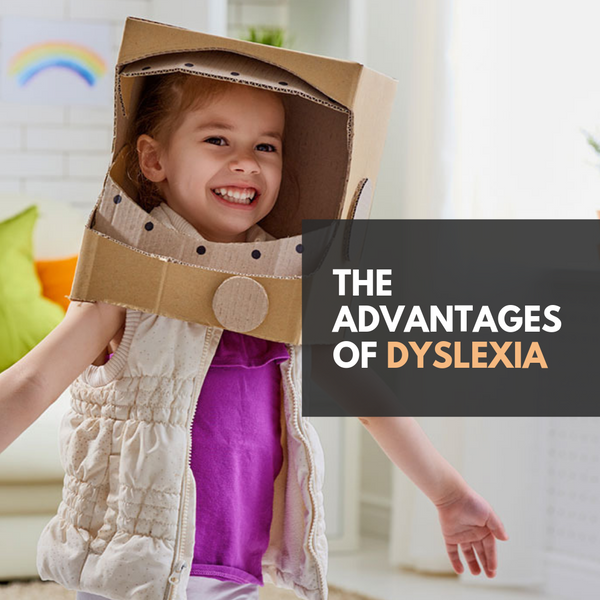The Advantages of Dyslexia

Those with dyslexia often struggle to recognize, spell, and decode words. Scientific research shows differences in brain connectivity between dyslexic and typical reading children, providing a neurological basis for why dyslexics struggle with reading fluency. Dyslexics not only use different parts of their brain when reading and working with language, but functional magnetic resonance imaging (fMRI) has shown that dyslexics have underactivity in some regions of the brain, and overactivity in others. Interestingly, this
neurodiversity proves to be a highly resistant gene, present in 10% of the global population. In recent years, scientists have pondered the evolutionary significance of the dyslexic brain, and have executed a number of empirical studies that reveal the specific areas in which dyslexics are more likely to excel. A greater awareness of these strengths and neurodiverse abilities can help parents and educators capture untapped talent, and maximise the strengths that dyslexia brings. Here is a list of five strengths that are often found in those with dyslexia:
1. Wonderfully Imaginative
Although there is no reliable data to indicate that those with dyslexia are more creative than other people, there are certainly a number of world-class musicians, authors, actors, artists, and entrepreneurs that would suggest that there is a correlation to some degree. UK research shows that 35% of US entrepreneurs and 20% of UK Entrepreneurs are dyslexic. Everatt's (1999) study also found that dyslexic adults showed signs of greater creativity, along with a more innovative problem-solving style approach.
From a young age, the emphasis is often on the visual, and dyslexics find themselves making great use of their imaginations as their way of processing and understanding information. This activates the areas of the brain that most people do not frequently use. The Yale Centre for Dyslexia and Creativity reports high creativity in children and adults with dyslexia is merely a result of the dedication and time dyslexics spend exploring new methods of learning. These individuals seek different and creative ways to problem solve and overcome difficulties. Andrew Pike, the Director of International Communications at the Prime Minister's (UK) Office and Cabinet Office Communications, states that "dyslexia is hugely beneficial — thinking differently and finding unconventional ways to problem solve comes naturally. This is important for decision making and has allowed me to deliver an impact to my role".
Some well-known creative dyslexics include Leonardo Da Vinci, Agatha Christie, John Lennon, Steven Spielberg, Tom Cruise, Robin Williams, Keira Knightly, Whoopi Goldberg, entrepreneur Richard Branson, supermodel Jerry Hall, and celebrity chef Jamie Oliver. If these names prove anything, it's that dyslexia does not reduce one's creative potential. Dr. Soren Petersen, design researcher, states that "many of the super creative designers I have worked with seemed to have one thing in common; they suffered from dyslexia".

2. Strong Visual Memory
A study by Enhanced Recognition Memory ... in Children with Development Dyslexia (2013) compared the performance of a group of 11-year-old dyslexic children with a group of non-dyslexic children on how well they remembered line drawings 10 minutes and 24 hours after first being shown the pictures. The results were clear, with dyslexic children being able to recall whether they had seen a picture before, performing at faster rates than the non-dyslexic children.
Another study conducted at Harvard University compared the abilities of college students with and without dyslexia for memorizing blurry-looking images resembling x-rays. Again, those with dyslexia showed an advantage over non-dyslexic students, benefiting those in the fields of science or medicine.
This difference in visual memory can be attributed to the greater brain connectivity to the visual cortex and parahippocampal region found in dyslexic children. These areas of the brain are tied to memory and memory retrieval of visual information that is relayed from the retina, and environmental scenes (i.e. images of places), while non-dyslexic children had stronger connections with the linguistic regions of the brain including the Visual Word Form Area. This why dyslexic kids often have a better memory of pictures rather than words.

3. Excellent Puzzle-Solving Skills
For the most part, dyslexics aren't subsequent thinkers that move chronologically from one idea to the next, but they thrive in a simultaneous thinking environment where ideas are connected via different routes. By seeing things more holistically, this helps them to quickly identify missing components to complete the broader puzzles. Dr. Matthew Schneps, Harvard's University's Director of the Laboratory for Visual Learning, states that "it's as if people with dyslexia tend to use a wide-angle lens to take in the world, while others tend to use a telephoto, each is best at revealing different kinds of detail".
Winner's (2000) study further fortifies this suggested trait, confirming that dyslexics excel in the detection of impossible figures. Dyslexic scientist Christopher Tonkin described his unusual sensitivity to "things out of place" when making sense of enormous quantities of visual data. These puzzle-solving skills are tied to the excellent ability for dyslexics to identify and memorize complex images. In one study, a test was conducted on professional astrophysicists with and without dyslexia to measure their abilities to spot the simulated graphical signature in a spectrum characteristic of a black hole. The results showed that scientists with dyslexia were better at picking out the black holes from the noise, proving to be an advantage useful in their careers.

4. Brilliant Visual Spatial Reasoning
Researchers at the University of East London found that many people with dyslexia demonstrate better skills at manipulating 3D objects, and remembering virtual environments when compared to non-dyslexics. While this evidence is limited, with studies as recent as 2016 concluding that there is "little evidence to support spatial advantages", what is apparent is that many dyslexics have proven to succeed in fields such as engineering, industrial and graphic design, architecture, as well as construction.
More research is needed to explore this ostensible dyslexia advantage. Studies in support of this trait are filled with contradictory literature that there are no differences between dyslexic people and controls. One report, however, that suggests that dyslexic children does have an exceptional strength in visual spatial reasoning includes Mirela Duranovic's study on 40 dyslexic children aged 9-11 with 40 age-matched, non-dyslexic controls. Both groups underwent a Paper Folding Test, which required looking at a depiction of how a piece of paper is folded and where a hole is punched through it, and then judging which one of several illustrations correctly depicted how the paper would look once unfolded. The test results showed that dyslexic children outperformed the controls, and were successfully able to conduct challenging and complex mental rotation tasks.

5. Great at Connecting with Others
Dyslexics have a great ability to sense, understand, and respond (emotionally and practically) to how people feel. This is because they are naturally visual-spatial learners and cannot automatically rely on text and audition for information. As a result, they tend to develop remarkable visual and intuitive abilities, including reading body language and facial expressions.
Researchers at MIT have also found that dyslexic people tend to distribute their attention far more broadly than non-dyslexics, which may help to grow their sense of social awareness. These researchers found that people with dyslexia not only could identify letters flashed simultaneously in the center and the periphery for spacings that were much further apart, but they also could pick out more words spoken by voices that were widely-distributed in a room. This ability to focus on the broader picture helps them to see beyond their own immediate concerns and interactions, observing others that may need help or assistance.

Summary
People often associate dyslexia to the inability to spell and read, ignoring the relevant strengths that this "re-wiring of the brain" can also pose. As demonstrated, dyslexics have many strengths that can be applied to the working world. They make up a huge percentage of the world's most successful physicians, scientists, creative professionals, and entrepreneurs. At Junior Learning, we want to help dyslexic kids reach their full potential by providing them with countless opportunities to use their imaginations, visualise and explore concepts through a multi-sensory approach, communicate and connect with others through game-play, and use new knowledge to solve puzzles creatively.
Here's a visual diagram to summarize the thinking and general skills that those with dyslexia tend to possess:
Source: www.madebydyslexia.org

Comments
0 Comments
Leave a Comment